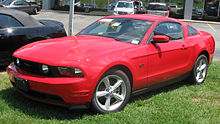2005-2009 MUSTANG
| Main article: Ford Mustang (fifth generation) Ford introduced a re-designed 2005 model year Mustang at the 2004 North American International Auto Show, codenamed "S-197", that was based on the new D2C platform. Developed under the direction of chief engineer Hau Thai-Tang, a veteran engineer for Ford's IndyCar program under Mario Andretti, and exterior styling designer Sid Ramnarace, the fifth-generation Mustang's styling echoes the fastback Mustang models of the late-1960s. Ford's senior vice president of design, J Mays, called it "retro-futurism". The fifth-generation Mustang was manufactured at the Flat Rock Assembly Plant in Flat Rock, Michigan. For the 2005 to 2010 production years, the base model was powered by a 210 hp (157 kW; 213 PS) cast-iron block 4.0 L SOHC V6, while the GT used an aluminum block 4.6 L SOHC three-valve Modular V8 with variable camshaft timing (VCT) that produced 300 hp (224 kW; 304 PS). Base models had Tremec T5 five-speed manual transmissions with Ford's 5R55S five-speed automatic being optional. Automatic GTs also featured this, but manual GTs had the Tremec TR-3650 five-speeds. The 2010 model year Mustang was released in the spring of 2009 with a redesigned exterior — which included sequential LED taillights — and a reduced drag coefficient of 4% on base models and 7% on GT models. The engine for base Mustangs remained unchanged, while the GT's 4.6 L V8 was revised resulting in 315 hp (235 kW; 319 PS) at 6,000 rpm and 325 lb⋅ft (441 N⋅m) of torque at 4,255 rpm.[67] Other mechanical features included new spring rates and dampers, traction and stability control system standard on all models, and new wheel sizes. Engines were revised for 2011, and transmission options included the Getrag-Ford MT82 six-speed manual or the 6R80 six-speed automatic based on the ZF 6HP26 transmission, licensed for production by Ford. Electric power steering replaced the conventional hydraulic version. A new 3.72 L (227 cu in) aluminum block V6 engine weighed 40 lb (18 kg) less than the previous version. With 24 valves and twin independent variable cam timing (TiVCT), it produced 305 hp (227 kW; 309 PS) and 280 lb⋅ft (380 N⋅m) of torque. The 3.7 L engine came with a new dual exhaust. GT models included 32-valve 5.0 L engine (4,951cc or 302.13 cu. in) (also referred to as the "Coyote") producing 412 hp and 390 ft-lbs of torque. Brembo brakes were optional along with 19-inch wheels and performance tires. The Shelby GT500's 5.4 L supercharged V8 block is made of aluminum making it 102 lb (46 kg) lighter than the iron units in previous years. It was rated at 550 hp (410 kW; 558 PS) and 510 lb⋅ft (690 N⋅m) of torque. For 2012, a new Mustang Boss 302 version was introduced. The engine had 444 hp (331 kW; 450 PS) and 380 lb⋅ft (520 N⋅m) of torque. A "Laguna Seca" edition was also available, which offered additional body bracing, the replacement of the rear seat with a steel "X-brace" for stiffening, and other powertrain and handling enhancements. In the second quarter of 2012, Ford launched an update to the Mustang line as an early 2013 model. The Shelby GT500 had a new 5.8 L supercharged V8 producing 662 hp (494 kW; 671 PS). The Shelby and Boss engines came with a six-speed manual transmission. The GT and V6 models revised styling incorporated the grille and air intakes from the 2010–2012 GT500s. The decklid received a black cosmetic panel on all trim levels. The GT's 5.0 liter V8 gained eight horsepower from 412 hp (307 kW; 418 PS) to 420 hp (313 kW; 426 PS). |
Fifth generation (2005–2014) |




